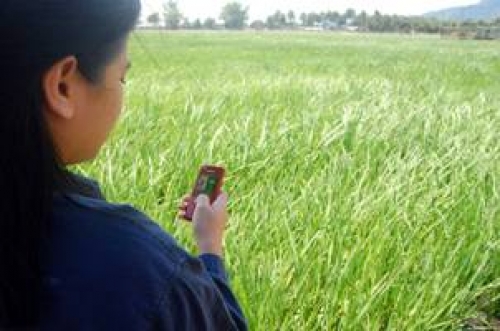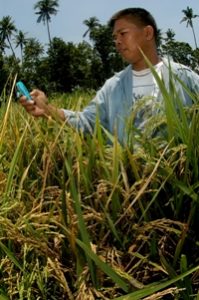
Farmers in the “texting capital” of the world—the Philippines—will soon have nutrient management advice tailored specifically to their rice crops delivered to their mobile phones.
Crop management has no such thing as a one-practice-fits-all solution. In fact, awareness is increasing throughout the world that crop management practices must be tailored to location-specific needs in order to produce more food with higher profitability and to reduce risks to the environment.
This is particularly important for the application of nutrients to cereal crops because optimal amounts and sources of nutrients to meet the needs of the crop can vary, even across short distances within and among fields. If the application of nutrients as fertilizers is insufficient, it can result in loss of yield and profit, whereas applications in excess of crop needs not only reduce profit but can also increase risks to the environment.
In Europe, North America, Australia, and parts of South America, where agriculture is mechanized on a large scale, concerns about the environment and high cost of fertilizers relative to the value of harvested crop have resulted in “precision agriculture” technologies. Precision agriculture aims to better match fertilizer applications with the spatial and temporal needs of the crop for nutrients. In large-scale farming, sophisticated technologies often based on crop sensors, global positioning systems, or remote sensing are being developed and used to carry out precision agriculture. This is unsuitable to most Asian rice farming, where fields and the entire landholding of one farmer are typically small—usually fractions of a hectare up to only a few hectares. Thus, sophisticated sensors must be replaced with other means for rapid, cost-effective acquisition and processing of location-specific information for a field.

A farmer uses his cellular phone to relay messages of a good planting season.Improvement in communication tools significantly helps farmers in trading their yield.
Computer-based decision tools with simple questions for farmers to answer and able to quickly provide a field-specific guideline represent a cost-effective option for small-scale farmers to implement precision agriculture. But such tools must be readily accessible to extension workers and farmers in rural areas.
Computers are one option for accessing decision tools provided either on a CD or via the Internet. But computers are not always readily accessible by small-scale farmers. Web-based mobile phones with Internet access provide another option but, again, not many farmers have such phones or Internet connectivity.
However, one alternative is available to many small-scale farmers: mobile phones with SMS (short message service) capability. With such mobile phones, text messaging and call centers are options for getting information to farmers. These require trained staff to handle texts and calls and ensure that accurate, timely, and consistent information is provided to farmers. Another way to reach many farmers with mobile phones is through interactive voice response (IVR).
With IVR, a farmer calls a phone number with a voice recording that presents a menu of questions about the farmer’s rice field and growing conditions. The farmer answers each question by pressing an appropriate number on the keypad. Once all questions are answered, the farmer receives a text message with a guideline on the amounts, sources, and timings of fertilizer application for his or her specific rice field.
The Nutrient Manager decision tool for rice has already been released and used with CD and Web-based applications in the Philippines. To reach more farmers, especially those without computers, the Philippines has been selected as the country to develop and provide, through a partnership with the public and private sector, a mobile phone–based IVR application that sends farmers a text message with a field-specific fertilizer guideline based on information they provide about their rice field. This tool is set to be released in mid-2010. More information on this tool will be featured in the next issue of Rice Today.
Information technology and mobile phone applications could change the role of extension workers. In the future, they could become less of a technical expert on a topic such as nutrient management and more of an expert on where and how to access information—an important role in orienting farmers to new IT tools and how to effectively use them.
Mobile phones are already capable of wireless banking and connecting farmers to microfinancing and loans, and purchasing power they have never had before. Bringing precision agriculture with IT to small-scale farmers can open up opportunities for farmers to obtain a fertilizer recommendation via a text message and then use their phone to access suppliers of the fertilizer and financing options to purchase it.
Nutrient Manager decision tools to provide field-specific guidelines for rice, wheat, and maize are now under development for specific countries and crop-growing regions. Information technology and the use of mobile phones offer the opportunity to bring precision agriculture to small-scale farmers. The farmer becomes the “sensor” for rapid, cost-effective acquisition of location-specific information, the IVR and Nutrient Manager software become the processors of this information, and the mobile phone becomes the vehicle for fast and effective transmission of the information to farmers.
Precision agriculture, such as field-specific nutrient management, could become available to small-scale farmers at their fingertips within a few minutes.
Dr. Buresh is a principal scientist, specializing in nutrient and crop management for intensive rice-based cropping systems, at the International Rice Research Institute.







